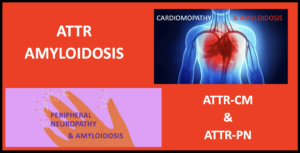
Over the course of the past two months, we spent time discussing two of the most common hallmark symptoms of ATTR amyloidosis: cardiomyopathy and peripheral neuropathy. In this article, we’ll briefly recap both hallmark symptoms as well as bring it all together by discussing the two most common forms of ATTR amyloidosis: ATTR cardiomyopathy (ATTR-CM) and ATTR peripheral neuropathy (ATTR-PN).
To recap …
Cardiomyopathy
Cardiomyopathy is a broad term that is used to describe disease of the heart muscle, making it difficult for the heart to provide the body with an adequate blood supply. It is a common cause of sudden cardiac arrest and sudden cardiac death, which can lead to heart failure and even death.
Types of Cardiomyopathy:
- Dilated Cardiomyopathy → dilation of the left ventricle prevents the heart from pumping effectively
- Hypertrophic Cardiomyopathy → abnormal thickening of the heart muscle most commonly surrounding the left ventricle
- Restrictive Cardiomyopathy → stiffening of the heart muscle results in an inelasticity
- Arrhythmogenic Right Ventricular Dysplasia → scar tissue replaces healthy tissue of the right ventricle
- Unclassified Cardiomyopathy → all other forms of cardiomyopathy fall within this category
Peripheral Neuropathy
Peripheral neuropathy, also referred to as polyneuropathy, is a very broad term used to describe damage of the peripheral nerves. Damage to these nerves most commonly causes numbness, pain, and weakness but can affect other areas of the body including, but not limited to, circulation, digestion, and urination.
Types of Neuropathy:
- Motor Neuropathy → damage to the motor nerves
- Sensory Neuropathy → damage to sensory nerves
- Autonomic Nerve Neuropathy → damage to autonomic nerves that control involuntary functions
- Combination Neuropathies → damage to a mix of 2 or 3 of these other types of neuropathies
ATTR Amyloidosis
The origin of this disease can be genetic (hATTR) or non-genetic, or “wild-type” (wtATTR). Regardless, in ATTR amyloidosis, the transthyretin (TTR) protein is misfolded and aggregates, forming amyloid fibers that deposit into tissues and organs. The deposition of protein causes organ dysfunction and can even cause organ failure and death.
ATTR-CM and ATTR-PN
Depending on the location of protein deposition, the disease is referred to in different ways. For instance, when the primary location of amyloid deposit is in the heart, the disease is referred to as ATTR cardiomyopathy (ATTR-CM). On the other hand, when the primary location of amyloid deposit is in the nerves, the disease is referred to as ATTR peripheral neuropathy (ATTR-PN).
ATTR-CM impairs the heart’s ability to pump effectively. A major challenge surrounding this disease is that symptoms of ATTR-CM are often similar to other heart conditions like enlarged heart and heart failure. This makes diagnosing the disease increasingly more difficult. Individuals with hATTR typically present symptoms in their 50s and 60s, whereas those with wtATTR may not present symptoms until their 70s and later.
Common Symptoms of ATTR-CM:
- Fatigue
- Swelling of legs, ankle, or abdomen
- Shortness of breath with activity
- Orthostatic hypotension
- Difficulty breathing when lying down
- Arrhythmia
ATTR-PN impairs the function of the nervous system. While amyloid most commonly builds up in the peripheral nervous system, deposition can also occur in the autonomous system. This results in a diversity of symptoms that are specific to the site of amyloid deposition. Symptom presentation is much more diverse, occurring as early as the 20s, or as late in life as the 70s.
Common Symptoms of ATTR-PN:
- Carpal tunnel syndrome
- Diarrhea and/or constipation
- Nausea, vomiting
- Loss of appetite
- Sexual dysfunction
- Muscle weakness
- Eye problems
- Orthostatic hypotension
===========================================================
References:
https://www.pfizer.com/news/articles/understanding_this_rare_disease_called_attr_amyloidosis
https://www.mayoclinic.org/diseases-conditions/cardiomyopathy/symptoms-causes/syc-20370709
https://www.yourheartsmessage.com
https://healthjade.net/familial-amyloidosis/
https://my.clevelandclinic.org/health/diseases/14737-neuropathy
https://www.hopkinsmedicine.org/health/conditions-and-diseases/peripheral-neuropathy
https://www.mayoclinic.org/diseases-conditions/peripheral-neuropathy/symptoms-causes/syc-20352061
https://practicalneurology.com/articles/2021-july-aug/neuromuscular-amyloidosis
https://healthjade.net/familial-amyloidosis/